INSTITUT SUPERIEUR D'ANTHROPOLOGIE
INSTITUTE OF ANTHROPOLOGY
ONLINE COURSES / COURS A DISTANCE
INSCRIPTION 2012 / Session III : Juillet 2012
REGISTRATION 2012 / Term III : July 2012
MEXIQUE – 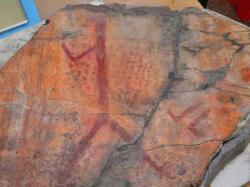 El Yathe - l'INAH présente une ambitieuse campagne de préservation et de restauration. Suite à la construction du barrage El Yathé dans la vallée de Mezquital, décision a été prise d'extraire trois panneaux de peinture rupestre de leur site pour les envoyer aux laboratoires de conservation et restauration. Actuellement 80 % de ces travaux ont été effectués et permettront prochainement d'exposer ces blocs de roche basaltique dans un musée ou lors d'une exposition itinérante.
El Yathe - l'INAH présente une ambitieuse campagne de préservation et de restauration. Suite à la construction du barrage El Yathé dans la vallée de Mezquital, décision a été prise d'extraire trois panneaux de peinture rupestre de leur site pour les envoyer aux laboratoires de conservation et restauration. Actuellement 80 % de ces travaux ont été effectués et permettront prochainement d'exposer ces blocs de roche basaltique dans un musée ou lors d'une exposition itinérante.
VIDEO = http://www.youtube.com/watch?v=9zkFW-dWrNc
http://inah.gob.mx/index.php/boletines/1-acervo/5921-rescatan-pinturas-de-2000-anos-de-antigueedad
COLOMBIE / EQUATEUR – 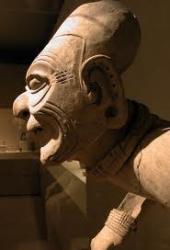 Tumaco / Tolita - Colombian expert Luz Miriam Toro's work to ensure that the value of pre-Columbian art from the Tumaco-Tolita culture is recognized throughout the world has earned her recognition from the Women Together (WT) organization that presented one of its annual awards to her on Tuesday. "My mission is to spread pre-Columbian art as widely as possible. On many occasions, people only remain on the borders. They only think about Mexico and they forget that further down from Mexico there were other cultures," Toro said, noting that one should not think that pre-Columbian art includes just that emanating from Mexico or Peru. "One must think that pre-Columbian art comes from Alaska to Argentina. My idea is for the Tumaco-Tolita culture to be recognized and for, when someone hears those names, them to recognize them just like when the Aztecs are spoken of. It has to be placed on the universal map of archaeology," the 64-year-old expert told Efe. "I've used all my resources in protecting my culture," Toro said, explaining that the Tumaco-Tolita culture flourished between 500 B.C. and 500 A.D. in the area around the port of Tumaco in Colombia and the island of La Tolita, in Ecuador.
Tumaco / Tolita - Colombian expert Luz Miriam Toro's work to ensure that the value of pre-Columbian art from the Tumaco-Tolita culture is recognized throughout the world has earned her recognition from the Women Together (WT) organization that presented one of its annual awards to her on Tuesday. "My mission is to spread pre-Columbian art as widely as possible. On many occasions, people only remain on the borders. They only think about Mexico and they forget that further down from Mexico there were other cultures," Toro said, noting that one should not think that pre-Columbian art includes just that emanating from Mexico or Peru. "One must think that pre-Columbian art comes from Alaska to Argentina. My idea is for the Tumaco-Tolita culture to be recognized and for, when someone hears those names, them to recognize them just like when the Aztecs are spoken of. It has to be placed on the universal map of archaeology," the 64-year-old expert told Efe. "I've used all my resources in protecting my culture," Toro said, explaining that the Tumaco-Tolita culture flourished between 500 B.C. and 500 A.D. in the area around the port of Tumaco in Colombia and the island of La Tolita, in Ecuador.
http://latino.foxnews.com/latino/entertainment/2012/06/05/luz-miriam-toro-recognized-for-preserving-pre-columbian-art/
INDE – 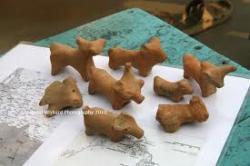 Saraswati river - A fresh study by a group of international scientists confirms the dominant role of Saraswati river in sustaining the so-called Indus Valley Civilisation. A new study titled, ‘Fluvial landscapes of the Harappan civilisation’, has concluded that the Indus Valley Civilisation died out because the monsoons which fed the rivers that supported the civilisation, migrated to the east. With the rivers drying out as a result, the civilisation collapsed some 4000 years ago. The study was conducted by a team of scientists from the US, the UK, India, Pakistan and Romania between 2003 and 2008. While the new finding puts to rest, at least for the moment, other theories of the civilisation’s demise, such as the shifting course of rivers due to tectonic changes or a fatal foreign invasion, it serves to strengthen the premise that the civilisation that we refer to as the Indus Valley Civilisation was largely located on the banks of and in the proximity of the Saraswati river. More than 70 per cent of the sites that have been discovered to contain archaeological material dating to this civilisation’s period are located on the banks of the mythological — and now dried out — river. As experts have been repeatedly pointing out, nearly 2,000 of the 3,000 sites excavated so far are located outside the Indus belt that gives the civilisation its name. In other words, the Indus Valley Civilisation was largely and in reality the Saraswati River Civilisation.
Saraswati river - A fresh study by a group of international scientists confirms the dominant role of Saraswati river in sustaining the so-called Indus Valley Civilisation. A new study titled, ‘Fluvial landscapes of the Harappan civilisation’, has concluded that the Indus Valley Civilisation died out because the monsoons which fed the rivers that supported the civilisation, migrated to the east. With the rivers drying out as a result, the civilisation collapsed some 4000 years ago. The study was conducted by a team of scientists from the US, the UK, India, Pakistan and Romania between 2003 and 2008. While the new finding puts to rest, at least for the moment, other theories of the civilisation’s demise, such as the shifting course of rivers due to tectonic changes or a fatal foreign invasion, it serves to strengthen the premise that the civilisation that we refer to as the Indus Valley Civilisation was largely located on the banks of and in the proximity of the Saraswati river. More than 70 per cent of the sites that have been discovered to contain archaeological material dating to this civilisation’s period are located on the banks of the mythological — and now dried out — river. As experts have been repeatedly pointing out, nearly 2,000 of the 3,000 sites excavated so far are located outside the Indus belt that gives the civilisation its name. In other words, the Indus Valley Civilisation was largely and in reality the Saraswati River Civilisation.
http://www.dailypioneer.com/columnists/item/51748-the-saraswati-civilisation.html
USA – 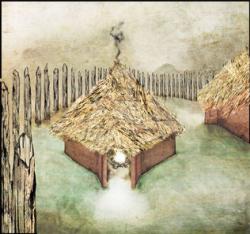 Morganton - The Charlotte Observer reported on an American Indian village unearthed in Morganton, North Carolina, in Catawba Meadows Park. Archaeologists have been pulling artifacts from the ground in Burke County for some time now. The Observer spoke to Emma Richardson, who has been part of the team researching the village. Richardson told the Observer that village hugged the banks of the Catawba River in present-day Morganton, and was likely circled by a wooden palisade, with village structures rising in a meadow where gardens flourished thank to the rich river-bottom soil. “Richardson also imagines a day in the 16th-century when villagers may have looked up from their toil and seen Spanish explorers arrive,” Observer reporter Joe De Priest writes. “The story of this clash of cultures will be told in a major living history project going up on the actual site of the village, now occupied by Morganton’s Catawba Meadows Park.”
Morganton - The Charlotte Observer reported on an American Indian village unearthed in Morganton, North Carolina, in Catawba Meadows Park. Archaeologists have been pulling artifacts from the ground in Burke County for some time now. The Observer spoke to Emma Richardson, who has been part of the team researching the village. Richardson told the Observer that village hugged the banks of the Catawba River in present-day Morganton, and was likely circled by a wooden palisade, with village structures rising in a meadow where gardens flourished thank to the rich river-bottom soil. “Richardson also imagines a day in the 16th-century when villagers may have looked up from their toil and seen Spanish explorers arrive,” Observer reporter Joe De Priest writes. “The story of this clash of cultures will be told in a major living history project going up on the actual site of the village, now occupied by Morganton’s Catawba Meadows Park.”
http://indiancountrytodaymedianetwork.com/2012/06/05/500-year-old-indian-village-unearthed-in-north-carolina-116509
SOMALILAND – 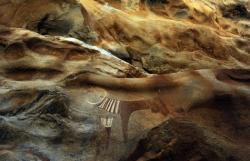 - Entre deux nids d’hirondelles apparaît une vache ocre rouge, affublée d’une sorte de plastron de toile, tracée par l’homme voilà cinq mille ans. Le contour est intact, la couleur éclatante, comme pour la quasi-totalité de ces extraordinaires peintures rupestres découvertes il y a dix ans par une équipe d’archéologues français. Venue au Somaliland fin 2002 afin d’étudier les cultures de la fin de la préhistoire, l’équipe dirigée par Xavier Gutherz parcourt la région à la recherche de grottes où effectuer des fouilles. La veille de leur départ, le 4 décembre, un jeune garçon les conduit à un grand rocher creusé d’alvéoles, perdu dans un paysage désertique. Le lieu, à la croisée de deux oueds, est baptisé par les bergers nomades Laas Geel, « les puits des chameaux » . Là, les archéologues « abasourdis » découvrent une constellation de peintures, dans une v ingtaine d’abris. Des centaines de vaches, des hommes, des chiens et même une girafe. « On a vu tout de suite que c’était un site important, qu’il était d’une qualité esthétique exceptionnelle, cela nous a beaucoup émus. Dans la carrière d’un chercheur, faire une découverte comme ça, c’est un moment très fort », se souvient Xavier Gutherz, archéologue et enseignant à l’université Paul-Valéry de Montpellier. Des missions archéologiques sont dès lors organisées chaque année jusqu’en 2010. Et, peu à peu, le site livre une part de ses mystères. Il s’agit d’abord de le dater, ce qui s’avère difficile. En 2003, des prélèvements microscopiques sont effectués sur une cinquantaine de peintures. L’idée est d’y chercher des traces de matière organique qui peut être datée au carbone 14. La tentative échoue. C’est de manière indirecte que les chercheurs parviennent à une datation. L’une des grottes abrite des sédiments qui n’ont pas été balayés par l’érosion. Des fouilles permettent d’y découvrir des vestiges d’occupation humaine : outils de silex, ossements d’animaux, fragments de roches colorantes utilisées pour les peintures et restes de charbon de bois. Datés, ces éléments permettent d’obtenir une estimation de l’âge des peintures : entre 3 500 et 2 800 ans avant notre ère. Laas Geel est non seulement « le plus important foyer d’art rupestre de la Corne de l’Afrique » , mais aussi le plus ancien, en conclut Xavier Gutherz. Mais beaucoup reste à découvrir. Si ces peintures sont certainement le fait d’éleveurs nomades, que signifient-elles ? Pourquoi cette sorte de plastron accroché au cou des vaches ? « Soit cela représente une cérémonie où effectivement les vaches étaient recouvertes de tissus qu’on leur posait sur le dos, ou alors c’est totalement symbolique. En tout cas c’est une mise en scène qui montre qu’il y a une relation particulière entre le bétail et les hommes, où la vache est l’animal sacré » , analyse Xavier Gutherz qui évoque un probable « sanctuaire » . « Les personnages ont les bras tendus, comme s’ils invoquaient des dieux. »
- Entre deux nids d’hirondelles apparaît une vache ocre rouge, affublée d’une sorte de plastron de toile, tracée par l’homme voilà cinq mille ans. Le contour est intact, la couleur éclatante, comme pour la quasi-totalité de ces extraordinaires peintures rupestres découvertes il y a dix ans par une équipe d’archéologues français. Venue au Somaliland fin 2002 afin d’étudier les cultures de la fin de la préhistoire, l’équipe dirigée par Xavier Gutherz parcourt la région à la recherche de grottes où effectuer des fouilles. La veille de leur départ, le 4 décembre, un jeune garçon les conduit à un grand rocher creusé d’alvéoles, perdu dans un paysage désertique. Le lieu, à la croisée de deux oueds, est baptisé par les bergers nomades Laas Geel, « les puits des chameaux » . Là, les archéologues « abasourdis » découvrent une constellation de peintures, dans une v ingtaine d’abris. Des centaines de vaches, des hommes, des chiens et même une girafe. « On a vu tout de suite que c’était un site important, qu’il était d’une qualité esthétique exceptionnelle, cela nous a beaucoup émus. Dans la carrière d’un chercheur, faire une découverte comme ça, c’est un moment très fort », se souvient Xavier Gutherz, archéologue et enseignant à l’université Paul-Valéry de Montpellier. Des missions archéologiques sont dès lors organisées chaque année jusqu’en 2010. Et, peu à peu, le site livre une part de ses mystères. Il s’agit d’abord de le dater, ce qui s’avère difficile. En 2003, des prélèvements microscopiques sont effectués sur une cinquantaine de peintures. L’idée est d’y chercher des traces de matière organique qui peut être datée au carbone 14. La tentative échoue. C’est de manière indirecte que les chercheurs parviennent à une datation. L’une des grottes abrite des sédiments qui n’ont pas été balayés par l’érosion. Des fouilles permettent d’y découvrir des vestiges d’occupation humaine : outils de silex, ossements d’animaux, fragments de roches colorantes utilisées pour les peintures et restes de charbon de bois. Datés, ces éléments permettent d’obtenir une estimation de l’âge des peintures : entre 3 500 et 2 800 ans avant notre ère. Laas Geel est non seulement « le plus important foyer d’art rupestre de la Corne de l’Afrique » , mais aussi le plus ancien, en conclut Xavier Gutherz. Mais beaucoup reste à découvrir. Si ces peintures sont certainement le fait d’éleveurs nomades, que signifient-elles ? Pourquoi cette sorte de plastron accroché au cou des vaches ? « Soit cela représente une cérémonie où effectivement les vaches étaient recouvertes de tissus qu’on leur posait sur le dos, ou alors c’est totalement symbolique. En tout cas c’est une mise en scène qui montre qu’il y a une relation particulière entre le bétail et les hommes, où la vache est l’animal sacré » , analyse Xavier Gutherz qui évoque un probable « sanctuaire » . « Les personnages ont les bras tendus, comme s’ils invoquaient des dieux. »
http://www.la-croix.com/Actualite/S-informer/Monde/Des-peintures-vieilles-de-5-000-ans-decouvertes-en-Somalie-_NG_-2012-06-05-814681